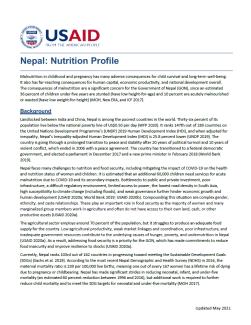Landlocked between India and China, Nepal is among the poorest countries in the world. Thirty-six percent of its population live below the national poverty line of US$0.50 per day (WFP 2020). It ranks 147th out of 189 countries on the United Nations Development Programme’s (UNDP) 2019 Human Development Index (HDI), and when adjusted for inequality, Nepal’s Inequality-adjusted Human Development Index (IHDI) is 25.8 percent lower (UNDP 2019). The country is going through a prolonged transition to peace and stability after 20 years of political turmoil and 10 years of violent conflict, which ended in 2006 with a peace agreement. The country has transitioned to a federal democratic government, and elected a parliament in December 2017 and a new prime minister in February 2018 (World Bank 2019).
Nepal faces many challenges to nutrition and food security, including mitigating the impact of COVID-19 on the health and nutrition status of women and children. It is estimated that an additional 60,000 children need services for acute malnutrition due to COVID-19 and its secondary impacts. Bottlenecks to public and private investment, poor infrastructure, a difficult regulatory environment, limited access to power, the lowest road density in South Asia, high susceptibility to climate change (including floods), and weak governance further hinder economic growth and human development (USAID 2020a; World Bank 2019; USAID 2020b). Compounding this situation are complex gender, ethnicity, and caste relationships. These play an important role in food security as the majority of women and many marginalized group members work in agriculture and often do not have access to their own land, cash, or other productive assets (USAID 2020a).
The agricultural sector employs around 70 percent of the population, but it struggles to produce an adequate food supply for the country. Low agricultural productivity, weak market linkages and coordination, poor infrastructure, and inadequate government resources contribute to the underlying causes of hunger, poverty, and undernutrition in Nepal (USAID 2020a). As a result, addressing food security is a priority for the GON, which has made commitments to reduce food insecurity and improve resilience to shocks (USAID 2020a).
Currently, Nepal ranks 103rd out of 162 countries in progressing toward meeting the Sustainable Development Goals (SDGs) (Sachs et al. 2019). According to the most recent Nepal Demographic and Health Survey (NDHS) in 2016, the maternal mortality ratio is 239 per 100,000 live births, meaning one out of every 167 women has a lifetime risk of dying due to pregnancy or childbearing. Nepal has made significant strides in reducing neonatal, infant, and under-five mortality (an estimated 60 percent reduction between 1996 and 2016), but additional work is required to further reduce child mortality and to meet the SDG targets for neonatal and under-five mortality (MOH 2017).

